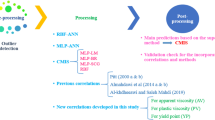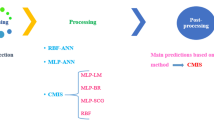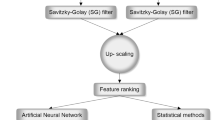Abstract
The prediction of drilling mud rheological properties is a crucial topic with significant importance in analyzing frictional pressure loss and modeling the hole cleaning. Based on Marsh viscosity, mud density, and solid percent, this paper implements a committee machine intelligent system (CMIS) to predict apparent viscosity (AV) and plastic viscosity (PV) of oil-based mud. The established CMIS combines radial basis function neural network (RBFNN) and multilayer perceptron (MLP) via a quadratic model. Levenberg–Marquardt algorithm was applied to optimize the MLP, while differential evolution, genetic algorithm, artificial bee colony, and particle swarm optimization were used to optimize the RBFNN. A databank of 440 and 486 data points for AV and PV, respectively, gathered from various Algerian fields was considered to build the proposed models. Statistical and graphical assessment criteria were employed for investigating the performance of the proposed CMIS. The obtained results reveal that the developed CMIS models exhibit high performance in predicting AV and PV, with an overall average absolute relative deviation (AARD %) of 2.5485 and 4.1009 for AV and PV, respectively, and a coefficient of determination (R2) of 0.9806 and 0.9753 for AV and PV, respectively. A comparison of the CMIS-AV with Pitt's and Almahdawi's models demonstrates its higher prediction capability than these previously published correlations.










Similar content being viewed by others
References
Skalle, P.: Drilling Fluid Engineering. Bookboon, Copenhagen (2011)
Hamoodi, A.; Rahimy, A.A.; Khalid, A.W.: The effect of proper selection of drilling fluid on drilling operation in janbour field. Am. Sci. Res. J. Eng. Technol. Sci. 39, 224–234 (2018)
Downs, J.D.; van Oort, E.; Redman, D.I.; Ripley, D.; Rothmann, B.: TAME: a new concept in water-based drilling fluids for shales. Offshore Eur. 93, 239–253 (1993). https://doi.org/10.2523/26699-ms
Tang, G.; Yu, P.: Mud loss control while drilling with oil base drilling fluid. Drill. Fluid Complet. Fluid. (2017) 4
Youcefi, M.R.; Hadjadj, A.; Boukredera, F.S.: New model for standpipe pressure prediction while drilling using Group Method of Data Handling. Petroleum (2021). https://doi.org/10.1016/j.petlm.2021.04.003
Balhoff, M.T.; Lake, L.W.; Bommer, P.M.; Lewis, R.E.; Weber, M.J.; Calderin, J.M.: Rheological and yield stress measurements of non-Newtonian fluids using a Marsh Funnel. J. Pet. Sci. Eng. 77, 393–402 (2011)
Marsh, H.N.: Properties and treatment of rotary mud. Trans. AIME. (1931). https://doi.org/10.2118/931234-g
Pitt, M.J.: The Marsh funnel and drilling fluid viscosity: a new equation for field use. SPE Drill. Complet. 15, 3–6 (2000). https://doi.org/10.2118/62020-PA
Almahdawi, F.H.M.; Al-Yaseri, A.Z.; Jasim, N.: Apparent viscosity direct from marsh funnel test. Iraqi J. Chem. Pet. Eng. 15, 51–57 (2014)
Wang, Z.; Lin, X.; Yu, T.; Zhou, N.; Zhong, H.; Zhu, J.: Formation and rupture mechanisms of visco-elastic interfacial films in polymer-stabilized emulsions. J. Dispers. Sci. Technol. 40, 612–626 (2019)
Deosarkar, M.P.; Sathe, V.S.: Predicting effective viscosity of magnetite ore slurries by using artificial neural network. Powder Technol. 219, 264–270 (2012). https://doi.org/10.1016/j.powtec.2011.12.058
Gharbi, R.B.C.; Mansoori, G.A.: An introduction to artificial intelligence applications in petroleum exploration and production. J. Pet. Sci. Eng. 49, 93–96 (2005). https://doi.org/10.1016/j.petrol.2005.09.001
Sayyafzadeh, M.: A self-adaptive surrogate-assisted evolutionary algorithm for well placement optimization problems. In: Soc. Pet. Eng. - SPE/IATMI Asia Pacific Oil Gas Conf. Exhib. APOGCE 2015, https://doi.org/10.2118/176468-ms (2015)
Helmy, T.; Hossain, M.I.; Adbulraheem, A.; Rahman, S.M.; Hassan, M.R.; Khoukhi, A.; Elshafei, M.: Prediction of non-hydrocarbon gas components in separator by using hybrid computational intelligence models. Neural Comput. Appl. 28, 635–649 (2017)
Ahmadi, M.A.: Prediction of asphaltene precipitation using artificial neural network optimized by imperialist competitive algorithm. J. Pet. Explor. Prod. Technol. (2011). https://doi.org/10.1007/s13202-011-0013-7
Amar, M.N.; Zeraibi, N.; Redouane, K.: Bottom hole pressure estimation using hybridization neural networks and grey wolves optimization. Petroleum 4, 419–429 (2018)
Amar, M.N.: Prediction of hydrate formation temperature using gene expression programming, J. Nat. Gas Sci. Eng. 103879 (2021)
Hegde, C.; Daigle, H.; Millwater, H.; Gray, K.: Analysis of rate of penetration (ROP) prediction in drilling using physics-based and data-driven models. J. Pet. Sci. Eng. (2017). https://doi.org/10.1016/j.petrol.2017.09.020
Youcefi, M.R.; Hadjadj, A.; Bentriou, A.; Boukredera, F.S.: Rate of penetration modeling using hybridization extreme learning machine and whale optimization algorithm. Earth Sci. Informatics. 13, 1351–1368 (2020)
Razi, M.M.; Mazidi, M.; Razi, F.M.; Aligolzadeh, H.; Niazi, S.: Artificial neural network modeling of plastic viscosity, yield point, and apparent viscosity for water-based drilling fluids. J. Dispers. Sci. Technol. 34, 822–827 (2013). https://doi.org/10.1080/01932691.2012.704746
da S. Bispo, V.D.; Scheid, C.M.; Calçada, L.A.; da C. Meleiro, L.A.: Development of an ANN-based soft-sensor to estimate the apparent viscosity of water-based drilling fluids. J. Pet. Sci. Eng. 150, 69–73 (2017). https://doi.org/10.1016/j.petrol.2016.11.030
Elkatatny, S.M.: Determination the rheological properties of invert emulsion based mud on real time using artificial neural network. Pet. Eng. - SPE Kingdom Saudi Arab. Annu. Tech. Symp. Exhib, Soc (2016) https://doi.org/10.2118/182801-ms
Al-Khdheeawi, E.A.; Mahdi, D.S.: Apparent viscosity prediction of water-based muds using empirical correlation and an artificial neural network. Energies 12, 3067 (2019)
Mu, Y.; Liu, X.; Wang, L.: A Pearson’s correlation coefficient based decision tree and its parallel implementation. Inf. Sci. (Ny) 435, 40–58 (2018)
Vaferi, B.; Eslamloueyan, R.; Ayatollahi, S.: Application of Recurrent networks to classification of oil reservoir models in well-testing analysis, energy sources part A recover. Util. Environ. Eff. 37, 174–180 (2015). https://doi.org/10.1080/15567036.2011.582610
Agwu, O.E.; Akpabio, J.U.; Alabi, S.B.; Dosunmu, A.: Artificial intelligence techniques and their applications in drilling fluid engineering: a review. J. Pet. Sci. Eng. 167, 300–315 (2018). https://doi.org/10.1016/j.petrol.2018.04.019
Witek-Krowiak, A.; Chojnacka, K.; Podstawczyk, D.; Dawiec, A.; Pokomeda, K.: Application of response surface methodology and artificial neural network methods in modelling and optimization of biosorption process. Bioresour. Technol. 160, 150–160 (2014). https://doi.org/10.1016/j.biortech.2014.01.021
Amato, F.; López, A.; Peña-Méndez, E.M.; Vaňhara, P.; Hampl, A.; Havel, J.: Artificial neural networks in medical diagnosis. J. Appl. Biomed. 11, 47–58 (2013). https://doi.org/10.2478/v10136-012-0031-x
Zaabab, M.N.A.H.; Zhang, Q.-J.: A neural network modeling approach to circuit optimization and statistical design. Adv. Sci. Lett. 22, 555–556 (2016). https://doi.org/10.1166/asl.2016.6861
Tighilt, Y.; Bouttout, F.; Khellaf, A.: Modeling and design of printed antennas using neural networks. Int. J. RF Microw. Comput. Eng. 21, 228–233 (2011). https://doi.org/10.1002/mmce.20509
Aiken, M.; Krosp, J.; M.V.-J. of E.U., undefined 1995, A neural network for predicting total industrial production, IDEA Gr. Publ. (n.d.)
Kumar, M.; Yadav, N.: Multilayer perceptrons and radial basis function neural network methods for the solution of differential equations: a survey. Comput. Math. with Appl. 62, 3796–3811 (2011). https://doi.org/10.1016/j.camwa.2011.09.028
Nilsson, N.J.; Machines, L.: Learning machines. J. Chem. Inf. Model. 53(2018), 1689–1699 (1965). https://doi.org/10.1017/CBO9781107415324.004
Hashem, S.: Optimal linear combinations of neural networks. Neural Netw. 10, 599–614 (1997). https://doi.org/10.1016/S0893-6080(96)00098-6
Perrone, M.P., Cooper, L.N.: When networks disagree: Ensemble methods for hybrid neural networks, Brown Univ Providence RI Inst for Brain and Neural Systems, 1992
Shokrollahi, A.; Tatar, A.; Safari, H.: On accurate determination of PVT properties in crude oil systems: Committee machine intelligent system modeling approach. J. Taiwan Inst. Chem. Eng. 55, 17–26 (2015). https://doi.org/10.1016/j.jtice.2015.04.009
Holland, J.H.: Adaptation in natural and artificial systems: an introductory analysis with applications to biology, control, and artificial intelligence. MIT press, Cambridge (1992)
Ahmadi, M.-A.; Bahadori, A.; Shadizadeh, S.R.: A rigorous model to predict the amount of Dissolved Calcium Carbonate Concentration throughout oil field brines: Side effect of pressure and temperature. Fuel 139, 154–159 (2015). https://doi.org/10.1016/J.FUEL.2014.08.044
Ahmadi, M.A.; Ebadi, M.; Marghmaleki, P.S.; Fouladi, M.M.: Evolving predictive model to determine condensate-to-gas ratio in retrograded condensate gas reservoirs. Fuel 124, 241–257 (2014). https://doi.org/10.1016/j.fuel.2014.01.073
Panigrahi, B.K.; Shi, Y.; Lim, M.-H.: Handbook of swarm intelligence: concepts, principles and applications, Springer 2011.
Eberhart, R.; Kennedy, J.: A new optimizer using particle swarm theory, In: MHS’95. Proc. Sixth Int. Symp. Micro Mach. Hum. Sci., IEEE, 1995: pp. 39–43.
Ahmadi, M.A.; Shadizadeh, S.R.: New approach for prediction of asphaltene precipitation due to natural depletion by using evolutionary algorithm concept. Fuel 102, 716–723 (2012)
Liu, Y.; Chen, S.; Guan, B.; Xu, P.: Layout optimization of large-scale oil–gas gathering system based on combined optimization strategy. Neurocomputing 332, 159–183 (2019)
Prata, D.M.; Schwaab, M.; Lima, E.L.; Pinto, J.C.: Nonlinear dynamic data reconciliation and parameter estimation through particle swarm optimization: application for an industrial polypropylene reactor. Chem. Eng. Sci. 64, 3953–3967 (2009). https://doi.org/10.1016/J.CES.2009.05.028
Shi, Y.; Eberhart, R.: Modified particle swarm optimizer. In: Proc. IEEE Conf. Evol. Comput. ICEC, pp. 69–73. https://doi.org/10.1109/icec.1998.699146(1998)
Storn, R.; Price, K.: Differential evolution—a simple and efficient heuristic for global optimization over continuous spaces. J. Glob. Optim. 11, 341–359 (1997). https://doi.org/10.1023/A:1008202821328
Storn, R.: Differential evolution design of an IIR-filter. In: Proc. IEEE Int. Conf. Evol. Comput., pp. 268–273. https://doi.org/10.1109/ICEC.1996.542373 (1996)
Karaboga, D.: An idea based on honey bee swarm for numerical optimization (Tech. Rep. No. TR06), Kayseri, Turkey Erciyes Univ. (2005)
Karaboga, D.; Basturk, B.: A powerful and efficient algorithm for numerical function optimization: Artificial bee colony (ABC) algorithm. J. Glob. Optim. 39, 459–471 (2007). https://doi.org/10.1007/s10898-007-9149-x
Anifowose, F.; Khoukhi, A.; Abdulraheem, A.: Investigating the effect of training–testing data stratification on the performance of soft computing techniques: an experimental study. J. Exp. Theor. Artif. Intell. 29, 517–535 (2017)
Rousseeuw, P.J.; Leroy, A.M.: Robust Regression and Outlier Detection. Wiley, New York (2005)
Gharagheizi, F.; Eslamimanesh, A.; Sattari, M.; Tirandazi, B.; Mohammadi, A.H.; Richon, D.: Evaluation of thermal conductivity of gases at atmospheric pressure through a corresponding states method. Ind. Eng. Chem. Res. 51, 3844–3849 (2012). https://doi.org/10.1021/ie202826p
Mohammadi, A.H.; Eslamimanesh, A.; Gharagheizi, F.; Richon, D.: A novel method for evaluation of asphaltene precipitation titration data. Chem. Eng. Sci. 78, 181–185 (2012). https://doi.org/10.1016/j.ces.2012.05.009
Mohammadi, A.H.; Gharagheizi, F.; Eslamimanesh, A.; Richon, D.: Evaluation of experimental data for wax and diamondoids solubility in gaseous systems. Chem. Eng. Sci. 81, 1–7 (2012). https://doi.org/10.1016/j.ces.2012.06.051
Author information
Authors and Affiliations
Corresponding author
Electronic supplementary material
Below is the link to the electronic supplementary material.
Appendices
Appendix A. Statistical Formulas
The statistical criteria employed to evaluate the proposed models are expressed as follows:
where \(Y_{{{\text{exp}}}}\) and \(Y_{{{\text{pred}}}}\) represent the experimental and predicted values of viscosity, respectively.
Appendix B. Supplementary Data
A supplementary file was uploaded to the system. This file contains the obtained weight factors \(C_{1} ,C_{2} \ldots C_{10}\) of the AV-CMIS and PV-CMIS, the centers \(C_{ij}\), the weights \(w_{i}\), and the bias of the AV-RBFNN-ABC, AV-RBFNN-DE, AV-RBFNN-PSO, PV-RBFNN-ABC, PV-RBFNN-DE, and PV-RBFNN-PSO;
Rights and permissions
About this article
Cite this article
Youcefi, M.R., Hadjadj, A., Bentriou, A. et al. Real-Time Prediction of Plastic Viscosity and Apparent Viscosity for Oil-Based Drilling Fluids Using a Committee Machine with Intelligent Systems. Arab J Sci Eng 47, 11145–11158 (2022). https://doi.org/10.1007/s13369-021-05748-8
Received:
Accepted:
Published:
Issue Date:
DOI: https://doi.org/10.1007/s13369-021-05748-8




